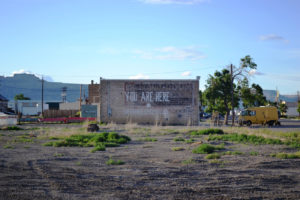Leadville was nearly named Colorado’s capital. In 1880, the two-mile-high city was one of  the world’s largest silver camps and boasted a population of 40,000. Today, the population rests at 2,602 and the economy has seen a drastic decline since the closing of Climax Mine in 1980.
the world’s largest silver camps and boasted a population of 40,000. Today, the population rests at 2,602 and the economy has seen a drastic decline since the closing of Climax Mine in 1980.
Green River, Utah was once a notable spot on the map: brought to life by the completion of the railroads in 1883, and later by the uranium rush of the 1940s. Today, the population hovers around 1,000 and closed businesses line Main Street.
In Leadville, I take in the old buildings, classic western main street, high peaks, and lingering tailings. Its former glory days are apparent, yet one can also appreciate its current modest appearance. Since the bust of the mining industry, Leadville has declined in both its economy and population.
As I walk around Leadville now, I think of Green River as we had been through it this past spring. I am sure that it has not changed much. I can imagine Nelly in the Green River Thrift Store shifting through books. I bet that RVs still dot the Green River State Park, and that a few cars are parked at the John Wesley Powell River History Museum. Perhaps the only difference is that the famed watermelons might be nearing ripeness.
The two towns bear an eerie resemblance to each other. Both were born from the American mining industry, both flourished from resource extraction, and both collapsed from dismantled mining productions. Or perhaps the resemblance is not eerie, but rather cliché. After all, both are western towns. Both are classic stories of boom and bust.
…
Four months ago, my classmates and I tried to familiarize ourselves with Green River, sleeping in Green River State Park by night, and frequenting the Melon Vine Food Store, Shady Acres Gas & Grocery, Green River Thrift Store, and Tacos La Pasadita – the famed taco truck in town – by day. Nonetheless, our curiosity remained. Where the hell were we? It wasn’t until our visit to the Epicenter that we began to piece together the story of the town that sits between canyons and nowhere.
The Epicenter, founded in 2009, is an organization dedicated to providing housing and business resources while promoting the arts, in hopes to create a sustainable community within Green River. Our visit with the founders informed us of the current western debacle: how does one “save” a boom-and-bust town without resorting back to the unsustainable trend of resource extraction, and without losing a town’s culture to industrial tourism?
Perhaps the answer lies 274 miles away in Leadville, Colorado. Since the closing of the Climax Mine in 1980, Leadville has sought to revamp their economy through a combination of tourism, and emphasizing its rich history and opportunities for outdoor recreation. The city has seen modest success through its annual festivities including Boom Days, a celebration of its past mining days; Skijoring, a ski competition held every winter on the main drag; and the Leadville Trail 100 series, the ultra bike and running races. In addition, its local businesses including Melanzana, an outdoor clothing company; City on a Hill, the beloved coffee spot; and Mule Kick, the eccentric vintage thrift store attract tourists and locals alike throughout the year. Though not as strong as it once was, Leadville’s economy has benefited, and the natural landscape no longer suffers from pillage.
So the question is, can Green River follow suit? How does the town maintain its historic culture, while making way for a sustainable economy driven not by resource extraction, but instead tourism? Thus far, the Epicenter has celebrated Green River for what it is through an art and literary magazine, the Green River Newspaper, and affordable housing projects. But what lies ahead? Could the local community be ready to open their town lines to the public through mining festivals or scenic train rides? Can they utilize the Green River and Book Cliffs to the best of their abilities, becoming another outdoor recreation mecca? And are there any entrepreneurs ready to take a gamble and open a local restaurant or business on E Main St.?